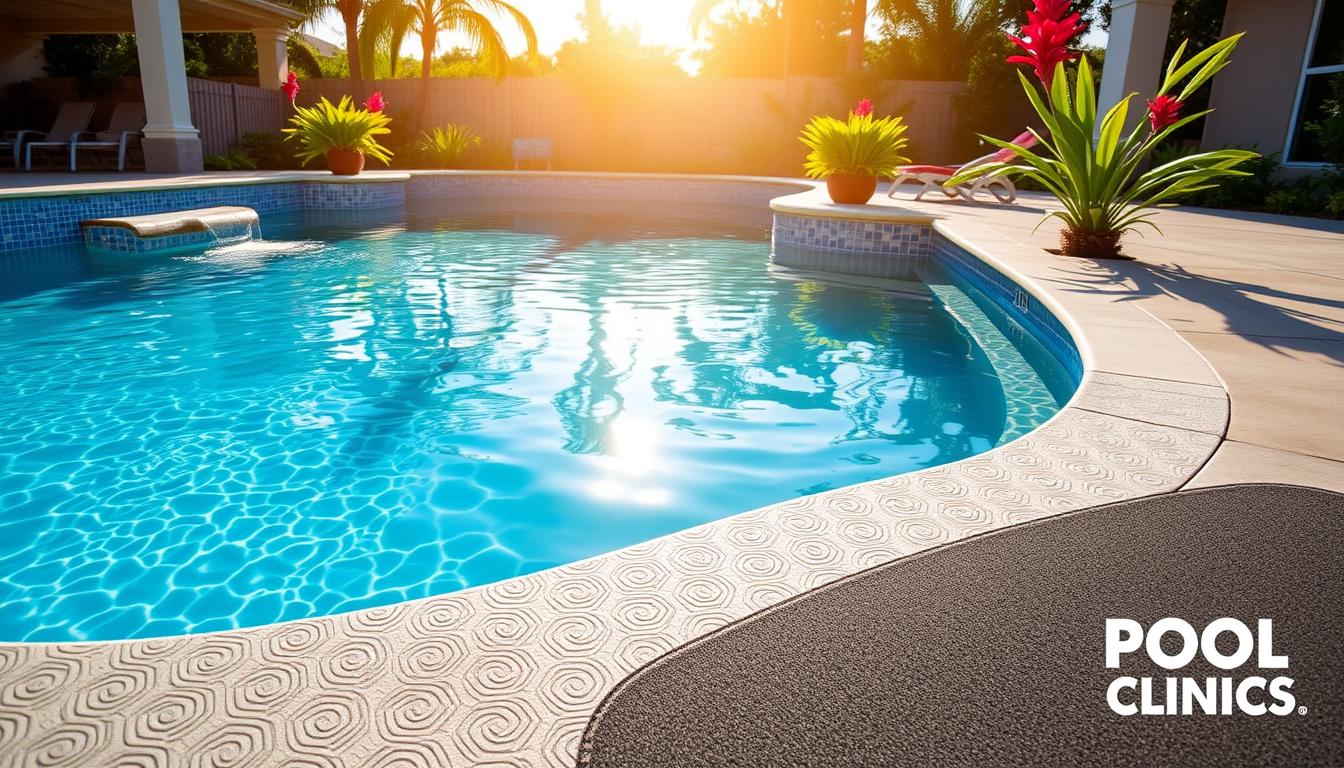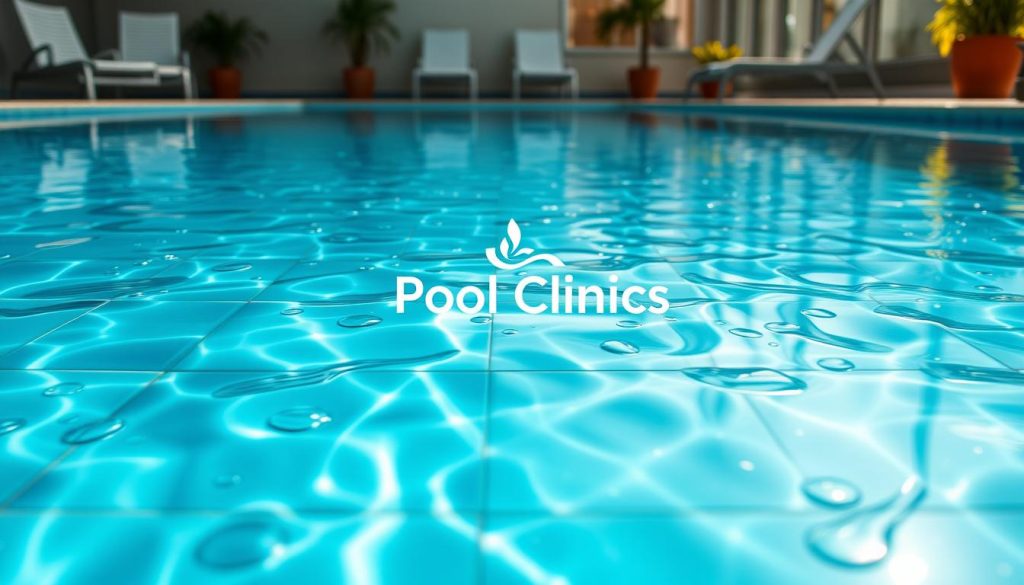
Diving into a crystal-clear pool on a hot day is thrilling. But slippery pool floors can turn joy into danger. They pose safety risks and ruin the fun of swimming.
Thankfully, effective solutions exist to tackle this problem. We can restore safety and comfort to your pool. Let’s explore how to make your pool slip-free.
Algae growth, mineral deposits, and body oils can make pool floors slick. These elements create a dangerous surface that may cause accidents. But with the right approach, you can eliminate these hazards.
We’ll explore causes of slippery pools and provide easy fixes. From thorough cleaning to anti-slip sprays, we’ll guide you through the process. We’ll also discuss regular maintenance and professional help.
Our guide covers solutions for fiberglass, acrylic, and tile pools. You’ll learn how to enhance deck safety and create a non-slip environment. By following these tips, you’ll enjoy worry-free swimming.
Key Takeaways
- Slippery pool floors pose a significant safety risk and can be caused by algae growth, mineral deposits, and the accumulation of body oils and sunscreen.
- Effective solutions include thorough cleaning and scrubbing, applying anti-slip sprays for fiberglass and acrylic pools, using Stone Grip for tile pool steps and flooring, and implementing non-slip paint for pool decks and surroundings.
- Regular pool maintenance, balanced water chemistry, and utilizing absorbent mats around the pool area are essential for maintaining a safe pool environment.
- Seeking professional assistance from companies specializing in pool maintenance can provide targeted solutions for slippery pool steps and surfaces.
- By implementing these solutions and incorporating regular maintenance practices, pool owners can ensure a slip-free and enjoyable swimming experience for their family and friends.
Understanding the Causes of Slippery Pool Floors
Slippery pool floors pose a major safety risk in high-traffic areas. Understanding the causes helps pool owners tackle this issue effectively. Let’s explore the factors that make pool floors slippery and how to address them.

Algae Growth and Buildup
Algae growth is a leading cause of slippery pool floors. It thrives in moist environments with poor chemical balance or circulation. Algae create a slick layer, making it hard for swimmers to keep their footing.
Regular pool maintenance is key to preventing algae buildup. This includes thorough cleaning and scrubbing to maintain a safe, slip-resistant surface.
Mineral Deposits from Hard Water
Hard water can leave mineral deposits on pool surfaces. As water evaporates, calcium and magnesium form a smooth layer on steps and flooring. This buildup reduces traction over time, making it unsafe for swimmers.
Water treatment solutions and regular cleaning can help solve this problem. These measures restore slip resistance and keep the pool safe.
Accumulation of Body Oils and Sunscreen
Body oils, sunscreens, and other contaminants can make pool floors slippery. These substances create a greasy film that reduces traction and increases fall risks. Encourage swimmers to shower before entering the pool.
Invest in effective filtration and sanitization systems. Applying anti-slip coatings to high-risk areas provides extra protection against slippery surfaces.
| Cause | Effect | Solution |
|---|---|---|
| Algae growth | Slick, slippery surfaces | Regular cleaning and scrubbing |
| Mineral deposits | Smooth, low-traction buildup | Water treatment and deposit removal |
| Body oils and sunscreen | Greasy film reducing traction | Pre-swim showers and anti-slip coatings |
Knowing these causes helps pool owners take action for safer swimming environments. A good maintenance routine with targeted solutions can greatly improve traction. These measures enhance pool safety and ensure a worry-free experience for all swimmers.
Effective Methods to Eliminate Slippery Pool Surfaces
Keeping your pool safe is vital to prevent accidents. Here are some ways to make pool surfaces less slippery. These methods will help reduce the risk of slips and falls.
Thorough Cleaning and Scrubbing
Use a pool brush to clean steps and surfaces. Remove algae, mold, or buildup. For tough spots, mix water and chlorine bleach.
Regular cleaning keeps your pool slip-resistant. This helps prevent accidents and maintains a safe environment.
Applying Anti-Slip Sprays for Fiberglass and Acrylic
Anti-Slip Spray creates a hard, textured finish on fiberglass and acrylic surfaces. It needs three coats and 72 hours to cure underwater. This product improves traction and reduces slip risks in your pool.
Using Stone Grip for Tile Pool Steps and Flooring
Stone Grip increases traction on porcelain, stone, or ceramic tiles. It works quickly, creating tiny treads on slippery surfaces. This product is great for pool steps and flooring.
Implementing Non-Slip Paint for Pool Decks and Surroundings
High-quality non-slip paint is perfect for pool decks and nearby areas. Deck Grip offers a clear, UV and chlorine-resistant finish. It’s ideal for sunny spots like patios and pool decks.
Dura Grip is another option for wood decks. It provides a durable, textured finish that improves slip resistance.
| Product | Surface Type | Key Features |
|---|---|---|
| Anti-Slip Spray | Fiberglass, Acrylic | Hard, textured finish; requires 3 coats and 72-hour cure time when fully submerged |
| Stone Grip | Porcelain, Stone, Ceramic Tiles | Creates microscopic treads; enhances traction within minutes |
| Deck Grip | Wood, Composite Decking, Concrete | Clear, water-based; provides grip, UV protection, and extends surface life |
| Dura Grip | Wood Decks | UV-resistant, durable textured paint finish; improves slip resistance |
These methods and products can make your pool safer. By using them, you’ll create a better environment for everyone to enjoy.
Maintaining a Safe Pool Environment
Pool safety is our top priority as responsible owners. We can prevent algae, bacteria, and other hazards that cause slippery floors. Regular maintenance and the right tools are key.
Regular Pool Maintenance and Cleaning
Consistent cleaning keeps pools safe and slip-free. We suggest these maintenance tasks:
- Weekly pool cleaning to prevent algae and bacteria growth
- Daily skimming of the pool surface to remove debris
- Weekly vacuuming to maintain clear water and visual appeal
- Brushing pool walls and floor to prevent algae and mineral deposits
- Regular cleaning of the pump basket and pool filter for optimal water flow
These tasks help keep our pool in top shape. They also lower the risk of slippery surfaces.
Maintaining Balanced Water Chemistry
Good water chemistry stops slippery pool floors. We should test and adjust these factors often:
| Parameter | Ideal Range | Frequency |
|---|---|---|
| pH | 7.2 – 7.6 | Weekly |
| Free Chlorine | 1 – 3 ppm | Weekly |
| Cyanuric Acid | 30 – 50 ppm | Monthly |
The right chemical balance prevents algae and bacteria growth. These can make pool surfaces slippery. Regular shock treatments help remove tough contaminants.
Utilizing Absorbent Mats Around the Pool Area
Absorbent mats around the pool boost safety. They reduce water buildup on hard surfaces, lowering slip risks. These mats give swimmers a secure surface when entering or exiting.
Seeking Professional Assistance for Targeted Solutions
Expert help is smart for those needing guidance. Companies like Pool Clinics offer specialized pool maintenance services. They can provide targeted solutions for slippery floors.
- Thorough inspection and assessment of pool surfaces
- Recommendations for effective cleaning and maintenance routines
- Application of anti-slip treatments tailored to specific pool materials
- Regular follow-up visits to ensure long-term slip resistance
Investing in professional pool maintenance services provides us with peace of mind, knowing that our pool is in the hands of experts who can help us eliminate slippery surfaces and maintain a safe environment for our family and friends.
Conclusion
Slippery pool floors pose a serious safety risk. Common causes include algae growth, mineral deposits, and body oils. Effective solutions involve thorough cleaning, anti-slip sprays, and stone grip for tiles.
Regular maintenance is key to preventing slippery surfaces. Balanced water chemistry and absorbent mats also help. For persistent issues, seek professional help to ensure a safe pool environment.
Pool Clinics offers expert reviews on top pool products. They provide insights on cleaning equipment, accessories, and safety gear. With proper care, your pool can remain a safe and inviting haven.







